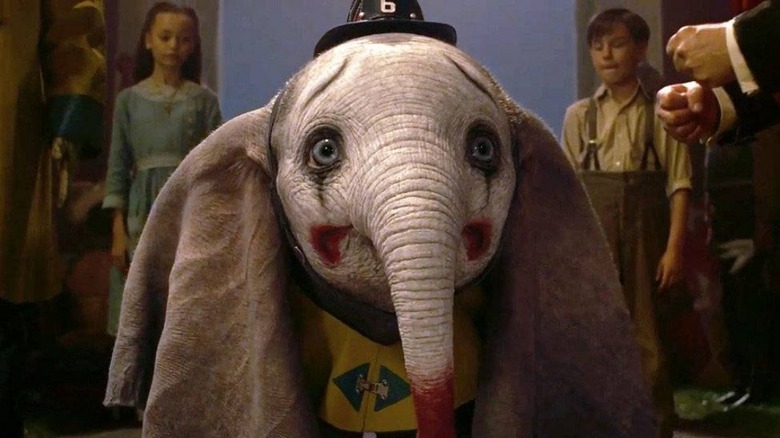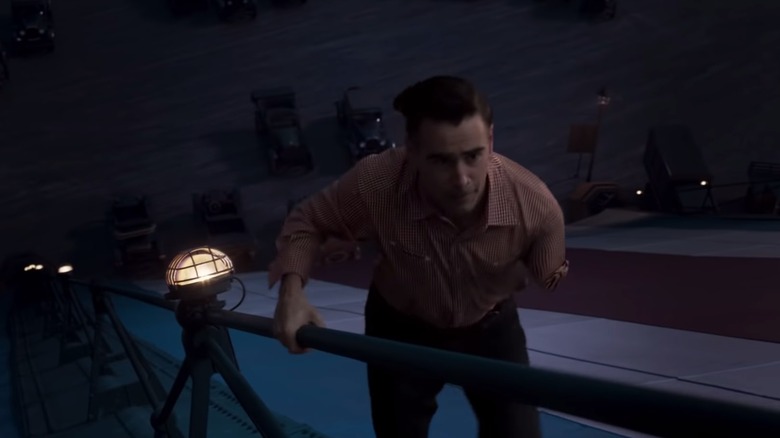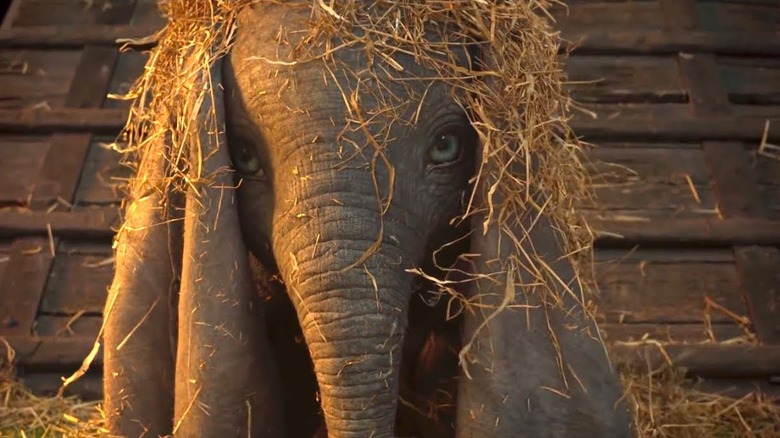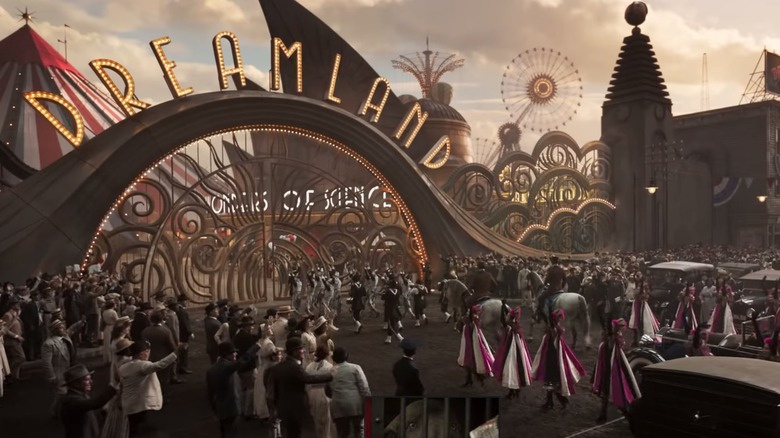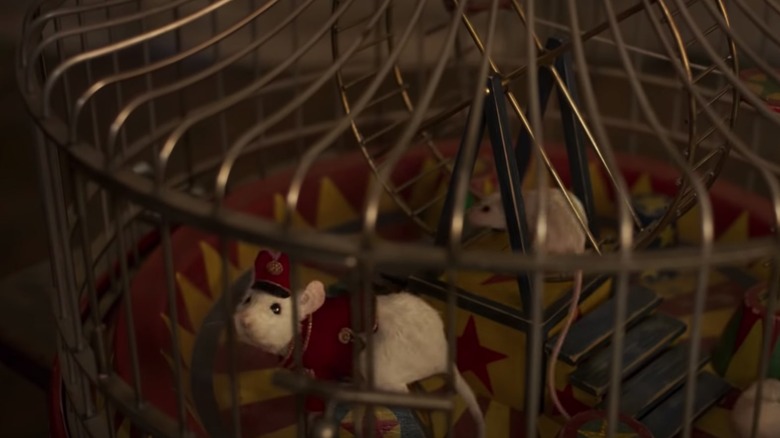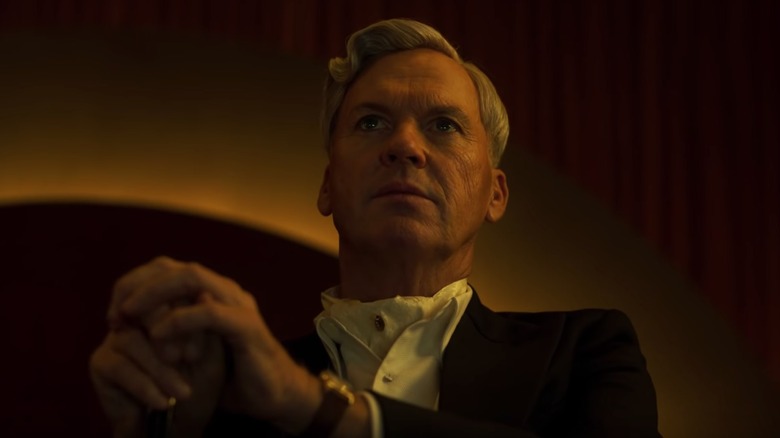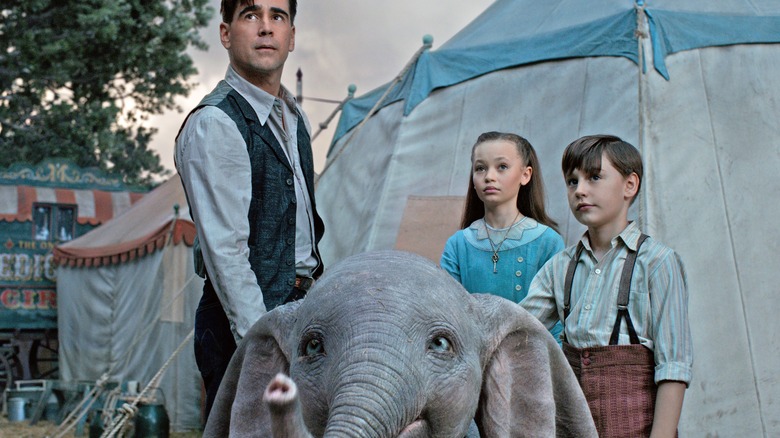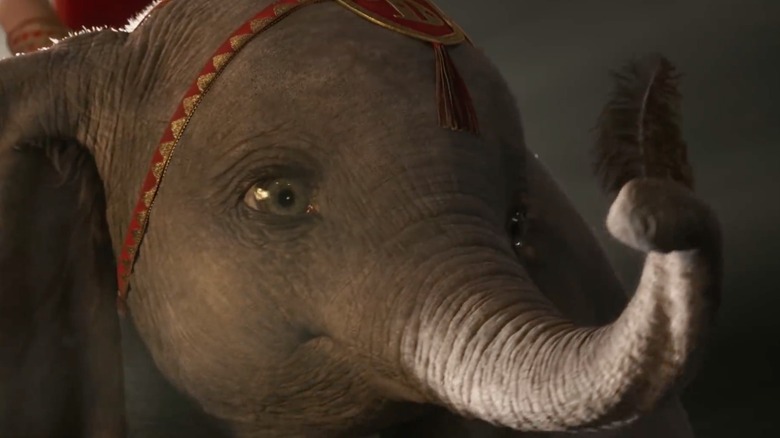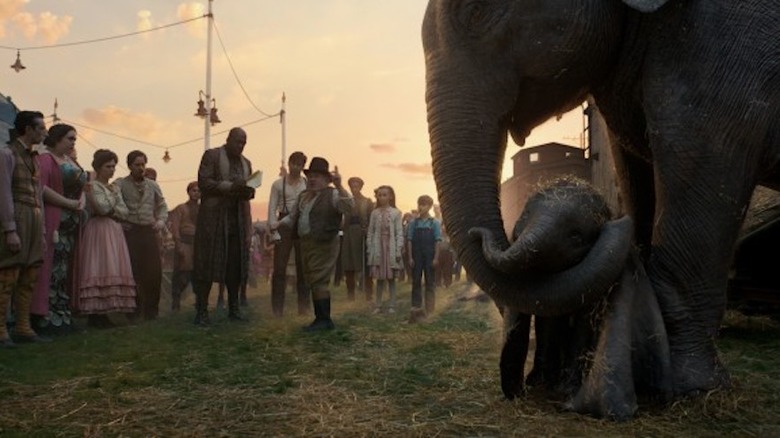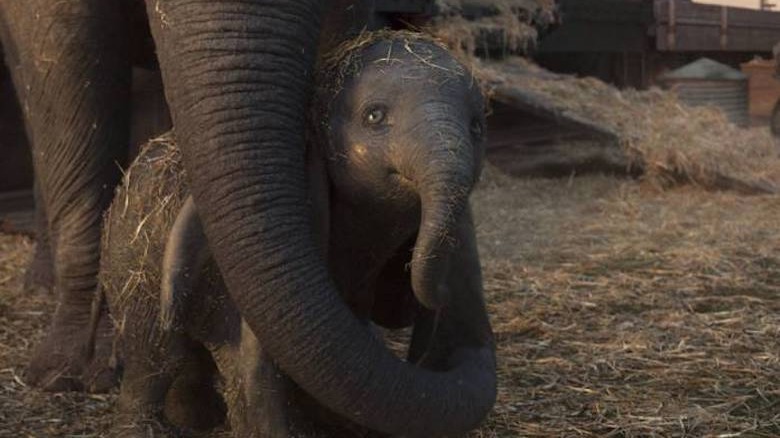Small Details You Missed In Dumbo
Dumbo, Disney's fourth animated film, was released in 1941 and has remained a fan-favorite ever since. The animated flick's universal themes of finding family among friends and using what makes you different to soar to new heights have certainly held their own throughout the years, so it only makes sense that the production studio chose to gift Dumbo fans with a live-action remake.
Disney's choice to give Dumbo new life on the big screen was a bold one, especially considering their decision to hire filmmaker Tim Burton — known for his dark and twisted themes — to direct the film. However, Burton made it clear in the very first trailer for his remake that, while he took his own creative liberties, he never forgot where the titular, famous flying elephant came from. From tiny homages, to repurposing beloved characters, to drawing real-life comparisons — here are the small details you may have missed in 2019's Dumbo.
The movie has a historical edge
In the beginning of Tim Burton's Dumbo remake, on-screen text provides the audience with a little context: the year is 1919. This bit of information is especially important, considering the next thing we're shown is Holt Farrier (played by Colin Farrell) arriving home from war. Since the year is 1919, it's safe to assume Holt has been away fighting alongside the Allies in World War I. And, judging by his missing arm, the fictional patriarch had quite a difficult time during battle.
Soon after Holt returns home — or rather, to The Medici Bros Circus — we learn through dialogue with Danny DeVito's ringleader character, Max Medici, that Holt's wife, circus partner, and the mother of his children died after a bout with influenza. The 1919 timeline matches up with the real-life influenza pandemic that struck the United States during 1918. According to the CDC's website, more than 100,000 Americans died from the flu during October of 1918, with the pandemic finally coming to an end in 1919. Perhaps that's why Holt's daughter has taken such an interest in science — so that she can one day help people like her late mother.
Hay there, Dumbo
When the audience first sees the newly-animated Dumbo in Disney's live-action remake, they can barely see him at all. That's because, in what can only be considered an homage to the original, 1941 film, Dumbo is covered in a pile of hay. It takes a moment for Holt Farrier and his two children, Milly and Joe, to even realize there's a baby elephant to be found at all. However, they soon see those unmistakable blue eyes peeking out through they hay pile.
Though the matriarchal elephant, Mrs. Jumbo, was pregnant only the day before, it's implied to the audience that she's given birth during the night when a stork lands for a moment on her circus train car. As you may remember from the original Dumbo, Walt Disney preferred to let his young audience believe that babies are actually delivered by stork, as that's exactly how the very first animated Dumbo was "born." There's no doubt that Burton had this iconic stork scene in mind when making the decision to have a flock of the white, long-beaked birds make a brief appearance.
Dreamland was real
A noticeable difference in Tim Burton's Dumbo remake is the presence of a most-malicious villain (played to perfection by Michael Keaton), V.A. Vandevere. The ill-intentioned entrepreneur buys The Medici Bros. circus after he reads of the flying baby elephant in the newspaper in an attempt to exploit little Dumbo for profit in his sprawling amusement park, Dreamland. If Dreamland sounds familiar, it may be because you've heard of the real-life Dreamland that once resided on New York's Coney Island. According to The Heart of Coney Island's website, the once-bustling amusement park ranks among Disney World and Luna Park "as one of the greatest amusement parks the world has ever known." Dreamland opened in 1904 and was a must-see attraction until meeting its demise in a 1911 fire.
Burton's Dreamland was likely inspired by the real-life version — but the director also very obviously tried to draw parallels between his fictionalized Dreamland and the very studio producing his Dumbo remake, Disney. Dumbo's Dreamland even featured an attraction called "Wonders of Science," much like Disney World's own, now-closed attraction, "Wonders of Life."
Timothy Q. Mouse has been replaced
As fans of Disney's original Dumbo will undoubtedly remember, the famous, flying baby elephant's best friend and biggest fan of all came in the form of one Timothy Q. Mouse — who was, as his name may suggest, was a mouse. Timothy Q. Mouse makes an appearance in Tim Burton's Dumbo remake, though his role has been largely restructured. While 1941's Timothy Q. Mouse has full autonomy and can speak, Burton's version is an actual, non-verbal mouse who lives mostly in a cage with other mice — all of whom are cared for by the young, aspiring scientist, Milly Farrier. However, while the new Timothy Q. Mouse can't speak to Dumbo, he's still sporting his unforgettable red bandleader costume.
Milly takes on the original talking mouse's role as Dumbo's best friend and biggest believer, as she's the first to realize that the little guy needs the help of a feather to flap his ears and soar to great heights. She even delivers some of Timothy Q. Mouse's famous lines, like when she prompts the baby elephant to "show them what [he] can do" before he takes his first public flight.
Walt Disney makes an appearance... sort of
As mentioned before, Tim Burton made no attempt to shy away from comparing his eery, fictionalized Dreamland amusement park to arguably the most famous real-life amusement park of all-time, Disney World. Burton's move was a bold one, considering Disney — the corperation which he clearly satirizes in his Dumbo remake — is the same studio which hired him to direct the much-anticipated 2019 film.
Even bolder was Burton's creative choice to introduce a villain in the form of Michael Keaton's V.A. Vandevere, who — as he is the proud owner of Dumbo's Dreamland — audiences can only assume is meant to be an exaggerated version of the mastermind behind Disney and its associated theme parks — Walt Disney himself. While the father of Mickey Mouse has a reputation in the hearts and minds of many for being a jovial, kind-hearted man (despite numerous accusations of racism, anti-Semitism, and noted discrimination against women in the creative workplace), Burton's Vandevere was an unapologetically evil symbol of the dangers of greed and capitalism. Perhaps Burton isn't the biggest Disney fan?
Everybody's lost something
While Tim Burton's Dumbo remake was noticeably (and expectedly) darker than its 1941 inspiration, the director used his creative liberty to tug on his audience's heartstrings and surround the flying baby elephant with friends who know the unfathomable feeling of loss he experiences as he watches his beloved mother, Mrs. Jumbo, being carried away as punishment for stampeding the circus in an attempt to protect her son.
For starters, Dumbo isn't the only one who's lost a mother. As audiences learn in the beginning of the film, Milly and Joe Farrier lost their mother to the influenza outbreak only months before their father, Holt Farrier, returns home from war. For his part, Holt has lost not only his wife, but also his arm — presumably from an incident during battle. And then there are the folks who make up The Medici Bros. freak show — each of whom have felt alone or abandoned in some way before making a make-shift family with their peers. The underlying message seems to be: "We're all freaks — and family — here."
Dumbo takes flight way earlier
If you were expecting a frame-for-frame remake of Disney's 1941 version of Dumbo, you were likely disappointed with Tim Burton's live-action remake of the classic film. However, if you've ever experienced a Burton film before (and we're guessing that you have), you probably expected the director to take creative liberty aplenty and give the flick his unmistakable flair.
Burton lets his audience know his film isn't their grandmother's Dumbo in the earliest moments of the 2019 remake when he incorporates war, amputation, and the death of a parent in the plot before even introducing the titular baby elephant. And while the overarching plot of the 1941 version saw a brokenhearted Dumbo performing various circus stunts and failing before realizing he can fly toward the end of the film, Burton's Dumbo stuns circus-goers with his miracle of flight very early-on in the film. The rest of the plot centers itself around Burton's indelible villain, V.A. Vandevere, and circus' mission to save Dumbo from Dreamland's greedy reach and reunite him with his mother.
"Mad elephant"
While Tim Burton made his Dumbo remake all his own — introducing vast changes to the plot of the original movie, as well as an entirely new cast of characters — the famous director made sure to include a number of "Easter eggs" for eagle-eyed viewers who fancy themselves true fans of the original 1941 Disney flick. Some of these hints and homages to the animated version of Dumbo were apparent from the live-action remake's very first trailer, which no doubt delighted fans of the flying baby elephant across the globe.
The first trailer for the 2019 film, released in 2018, opens with a weather vane featuring the silhouette of a baby elephant following a larger elephant, his trunk tied around her tail. The 1941 Dumbo shows the titular elephant following his mother with his trunk around her tail multiple times, so Burton's weather vane was an obvious tip-of-the-hat to the original animated flick. Another Easter egg shown in the trailer (as well as the film) is the "Mad Elephant" sign displayed outside Mrs. Dumbo's cage after she causes a scene during the circus while protecting her newborn son.
PETA may have had a hand in the happy ending
The original, 1941 version of Dumbo was heartbreaking enough with the flying baby elephant being separated from his loving, protective mother, Mrs. Jumbo, early in the film. Director Tim Burton — known for his penchant for all things dark and gloomy — kicks the heartbreak up a notch when he has Mrs. Jumbo sold off and carried away to an unknown fate as a consequence of her causing a stampede during a performance (in the original version, Mrs. Jumbo was able to stay with the circus). Baby Dumbo's famous blue eyes well up with tears as he watches his beloved mother being taken, and we're willing to bet you'll shed a tear or two, yourself.
However — spoiler alert — Burton gifts fans with a happy ending when Dumbo is rescued from the clutches of V.A. Vandevere and is released into the wild (or an animal sanctuary) with his mother, Mrs. Jumbo. PETA (People for the Ethical Treatment of Animals) called for this exact ending in 2015 when Burton was announced as director of the 2019 remake, and it seems he heard their call and took note.
